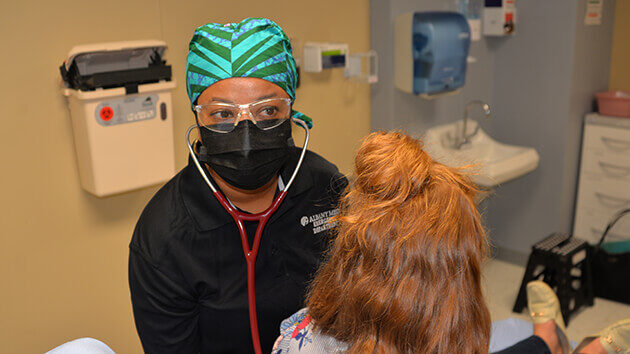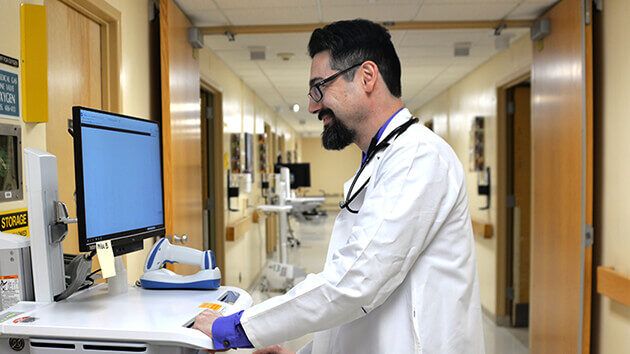She Puts the ‘A’ in Advanced Practice Provider

Pamela Young, PA-C, ’01, was 7 years old when her mother passed away. She was living in the Bronx, and the woman she calls her grandmother, despite that they are not related by blood, took her under her wing and moved her to Long Island.
“She was an amazing woman,” Young said. “Very strong and very strict. She came up in the Depression era and raised four girls by herself. Then I came along. We didn’t have a car. Everything I had she worked for.”
Her grandmother’s influence would follow her north when she enrolled at St. John Fisher and then transferred to the University at Albany with plans of becoming a journalist. For the next six years—while she was in college and, again, after she graduated—Young worked two to three jobs at a time to support herself, modeling her grandmother’s strong work ethic.
“My primary job was always at Albany Med,” she said. “I started out as a nutritional liaison, delivering food to patients.” Concurrently, in those early days, she worked as both a receptionist and driver at the Arbor Hill Community Center.
“There’s an APP for That”
Advanced practice providers are medical professionals with specialized training whose ranks include physician assistant (PA), nurse practitioner (NP), and nurse anesthetist (CRNA). In collaboration with physicians and surgeons, APPs can diagnose and evaluate patients, order tests, interpret data and provide treatment. They are able to perform in-office procedures, assist in surgery, and, in most cases, prescribe medication.
Albany Med employs nearly 400 APPs. They can be found across the hospital, its practice sites and in all its EmUrgentCare locations. They represent the full spectrum of disciplines—from family practice to specialized surgery to palliative care—and their collective talents account for an enormous cornerstone of care at Albany Med.
Young married her high-school sweetheart in 1997, and, one fateful day, her husband, who is now an officer with the Albany Police Department, got into a motorcycle accident. As she sat in the Emergency Department, watching a care team administering to his wounded leg, she thought, “This is really cool work. I could do this.”
Today, Young is a physician assistant and the advanced practice practitioner (APP) director in the Emergency Department, where she oversees a team of 30. APPs are clinicians with advanced training who can diagnose, treat and manage the care of patients.
“Dr. Pauzé”—Denis Pauzé, MD, chair of the Department of Emergency Medicine—“calls us his Special Forces,” Young said.
The quicksilver dexterity she learned when she was juggling multiple jobs earlier in her career now serves her well in the ED. On a given day, Young might provide care to a 30-year-old with a kidney infection, an 85-year-old in respiratory distress and a 19-year-old with a broken arm—all on the same shift.
The demands of her position, as well as the comfort it affords, allow her to work only one job now, but she hasn’t slowed down any. She is the current chair of Albany Med’s APP Steering Committee. For three years she has spearheaded monthly education sessions for the department’s APPs so they can stay at the leading edge of care. She is also pursuing an MBA, because she says she wants to be a better manager.
“You would be hard-pressed to find a more engaged Albany Med employee,” Dr. Pauzé said. “She is constantly working on ways to improve and optimize emergency care for our patients. And she is an outstanding clinician, the person you would want to take care of one of your own family members if they found themselves in the ED.”
The bonds among the department’s APPs are uncommonly strong. Prior to the coronavirus pandemic, they vacationed together (Key West, the Adirondacks, spa days in the Berkshires) and celebrated special occasions as a group.
Mara McErlean, MD, director of the Patient Safety and Clinical Competency Center, has observed Young when she brings the department’s APPs in for their monthly education sessions.
“Pam reminds me of the pied piper, coming down the hall with a trail of happy learners behind her,” she said. “They all seem to be delighted to be together, intent on whatever simulation they are taking instruction from, and then they are on their way. Off to the next health care challenge.”
